It was a sad day, sort of like taking your old dog to the veterinarian to be put down. I knew I was handing over a good friend and would be driving away with an empty truck and a lot of memories.If I'd known it was going to look so good inside, I wouldn't have taken it apart. And as much as that sounds like an ad slogan to you Honda skeptics, it is as true as could be.That was all I could say as we piled the parts, formerly a perfectly well-abused motorcycle, into a plastic box where it would head back to American Honda to be reassembled by some poor guy in the service shop. At 215 hours, our Long Haul CRF was still a very healthy motorcycle. While the CRF moniker has implications of high performance and lots of maintenance attached to it, in reality, this bike was a lot more XR-like than even I'd imagined.Since its last update, we were mostly prepping the bike for its final hurrah-a test at the DR 24-Hour. Because it wouldn't be right to bring a totally battered and beat-looking date to the party, I spruced it up with some fresh plastic. Roughly $200 for the cosmetic-only makeover worked wonders for the bike. The old stuff, with its Powersport Grafx Gripz decals, was only suffering from crash-induced fatigues and was actually wearing through in some spots, not peeling off as most stickers finally do. Taking the one excessive step, as usual, we tore off perfectly good stock graphics (which come on the replacement plastic) and gave the bike a unique Cycra look with custom Factory Effex graphics, since the guys from the Ohio-based company were coming out to help us ride it during the 24-Hour. Improvements here included going with the Cycralite front fender and replacing the bent hand guards with Cycra's Probend alloys. Our big find was a billet-aluminum Pro Circuit T-6 clutch cover to replace the JB Weld-ed, brittle stock magnesium unit, of which we've destroyed two.Our other lingering problem has been the countershaft seal weeping a bit. Some string got behind the sprocket and wasn't great for the seal. We've replaced it twice ourselves, but it continued drooling a very (immeasurable) small amount of tranny fluid. Finally, we had a trained Honda mechanic do it and it stopped-maybe he had a more killer set of tools?The final prep consisted of installing our supplied official DR 24-Hour numberplate backgrounds from Powersport Grafx and getting the super-hookup from Michelin. The company got us an M12 front and an S12 rear tire, and to make sure flats weren't a problem, Michelin installed Bib Mousse inserts.One interesting note was that the CRF, through modifications and the like, had gained nearly 10 pounds since last year. Bolting on stuff rarely lightens the bike, and we did plenty of bolting on. But all of the stuff served a purpose, from protection, such as the Works Connection skid plate and radiator guards, to the T.M. Designworks chain guide. When the radiator was crushed in the Glen Helen 24-Hour, the guard stopped it from tearing apart and in turn leaking, allowing the bike to finish the race. Our IMS tank got us the extra fuel capacity to stretch gas stops to near the 120-mile mark with only minor width implications.
Throughout our year with the bike we tried three distinctly different aftermarket mufflers. The stock muffler (with only the pea shooter, not the whole insert removed) is hard to beat for all-around ridability and for being so quiet. The Akrapovic gave the bike more low-end snap and mirrored the stock pipe everywhere else-always a little louder. The Leo Vince kept the sound level nearly as quiet as stock, even in the upper Rs, and smoothed and boosted power everywhere. Then the White Brothers' E2, which was the loudest of the pipes we tried, had both snap and lots of power on top, as well as being really tight in the build quality with solid, not wraparound, band mounting.We were continually impressed with the improvement the Pro Circuit suspension brought to the bike in compliance, plus it gave the Honda a lighter, nimbler feel. Combined with the Scotts steering stabilizer, it made the bike way easier to ride. Some may scoff at the final prices for modifications and replacement parts on this bike, but considering most of the damage was done at one brutal 24-hour race, it could have been a lot less. And the improvement for the modification's cost was well worth the price.The DR 24-Hour was actually a breeze for my Long Haul baby, whereat every rider was impressed with its performance and even more shocked by how much time was on the machine without much maintenance. In total, the valves were checked about 10 times. We had to adjust each exhaust valve one time. Three clutches were used up, all replaced as a precautionary measure. And other than a clutch lever pivot bolt seizing up, there weren't any other failures to speak of. We did the usual preventive maintenance and noted that the rubber seals around bearings did a good job keeping grease in and water out. Bolts were never too small for the job and always had enough thread area to prevent stripping. And when they did, such as the brake pivot bolt (not removing the circlip) and the rear valve cover bolt (bad alignment), it could have easily been prevented with a little more caution on the mechanic's part. The CRF still had a very tight feel in the engine performance and the chassis. That is one thing we are finding with older aluminum frames: They don't get sloppy.At the teardown we were especially impressed with the lack of rust and corrosion on pivot and mounting bolts. And once we got inside the engine, it was unbelievable. The only real signs of wear were on the lower portions of the piston skirt, which were well-polished. The hone marks were still on the cylinder walls and the rings even measured well within end-gap spec. The clutch basket was hardly galled, surprising considering all of the abuse the CRF has been through. Inside the tranny, the gears and shafts looked great, with only the slightest rounding on a couple of the dogs. All normal stuff. A tribute to the Honda HP4 oil we kept fresh through the test. The valves had very little, if any, visible wear on them and only a light coat of carbon, which was less than some 30-hour motors we've seen lately.We did find a problem on the shock. The aluminum spring preload ring had seized on the shock body. Being that this is the second time we've encountered this, we're looking to stay with the steel ones on future projects or look into a lube that prevents this from occurring.All in all, this bike way surpassed our expectations, especially in light of some of the earlier-year model CRF concerns of shortened valve and piston life. And from what we can detect, most of the transmission issues, which only happened to a very minute amount of units, all had a few things in common. They were very fresh bikes that were being used for high-speed road riding-generally with suspected low tranny fluid levels. It would be safe to add an extra 50-100cc beyond the recommended capacity and don't rely on the check hole for an accurate level check. We'd figured we could easily get another 200 hours on the bike, which in the real world is a lot of time.We were sad to see this bike go, but it opens up the door for some fresh meat in our off-road Long Haul fleet. That means more riding, and we're all about that! Cramming another 200-plus hours on another bike is going to be fun. We hope it goes this smoothly!Running Tally
Hours on Bike: 215
Modifications Cost Total: $2840.25
Rear fender: $45.53
Right and Left radiator shroud: $56.23 each
Right and Left sidepanel: $30.03, left; $50.42, right
Cycralite front fender: $43.95
Probend hand guards: $109.95
Maintenance and consumable parts: $2131.11 (not including tires)
Pro circuit T-6 Clutch Cover: $149.95
2 oil changes with Honda HP4: $29.76
IRC M5B rear tire $77.95
(3) Countershaft seal: $7.13
(3) Countershaft O-ring: $2.47
(3) Countershaft sleeve: $10.02
Michelin M12 90/90-21: $85.22
Michelin Bib Mousse M15: $164.53
Michelin S12 140/80-18 : $94.53
Michelin Bib Mousse M14: $164.47

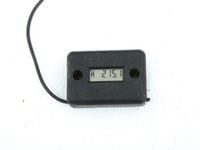
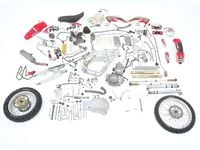
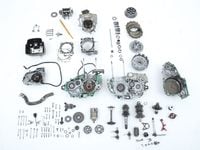
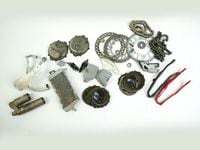
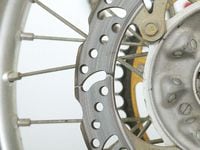


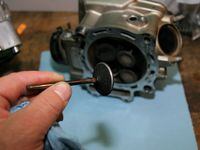
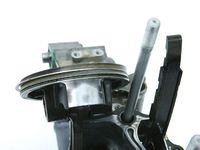
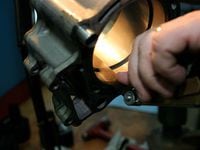
/cloudfront-us-east-1.images.arcpublishing.com/octane/44W4OD5KDZFD3FQWWHZV63P4TY.jpg)
/cloudfront-us-east-1.images.arcpublishing.com/octane/SQ3CEIVCOJF7FDERDVDKKPIC7A.jpg)
/cloudfront-us-east-1.images.arcpublishing.com/octane/LLLQLRK2DBH4PN66MDNA3AFJNY.jpg)
/cloudfront-us-east-1.images.arcpublishing.com/octane/5DMU4K752FBWLLJD432GRAAH2A.jpg)
/cloudfront-us-east-1.images.arcpublishing.com/octane/TGHDVMIODJC4BNKJDZKKTSWXWI.jpg)
/cloudfront-us-east-1.images.arcpublishing.com/octane/5KYMT24REJEFPNO2J2M76MXERM.jpg)

/cloudfront-us-east-1.images.arcpublishing.com/octane/3GXGR3EKSNH5NI3CWHV5SJ7TXE.jpg)
/cloudfront-us-east-1.images.arcpublishing.com/octane/JEU3ONDWEFCAZNAZJOU24OJ2PM.jpg)
/cloudfront-us-east-1.images.arcpublishing.com/octane/JQ6LMK6LLBAQJIL2AH56UIUKWU.jpg)
/cloudfront-us-east-1.images.arcpublishing.com/octane/QUSF4LLRM5DDPCJW25RINQRJPE.jpg)
/cloudfront-us-east-1.images.arcpublishing.com/octane/FYDGK7GF4JBPXERA5RAZPY3YJI.jpg)
/cloudfront-us-east-1.images.arcpublishing.com/octane/JE7KMNASNRGR7FLYAFRZAR7T7E.jpg)
/cloudfront-us-east-1.images.arcpublishing.com/octane/7RCNKJJNXBF4LBKZXE2INNWZUY.jpg)
/cloudfront-us-east-1.images.arcpublishing.com/octane/BAGM5E4EWBHFNLZOXMSLOLKQGU.jpg)
/cloudfront-us-east-1.images.arcpublishing.com/octane/RSX65VBXY5FRLIY4LN6WLOKAFM.jpg)
/cloudfront-us-east-1.images.arcpublishing.com/octane/3EO2CNKWUFBGNMGNJPETW5HCNY.jpg)
/cloudfront-us-east-1.images.arcpublishing.com/octane/IYHM55XRNVHF3DSS3467PZ7ONQ.jpg)
/cloudfront-us-east-1.images.arcpublishing.com/octane/L7K3FIINEBHMZI2TXTUE4FXH7I.jpg)
/cloudfront-us-east-1.images.arcpublishing.com/octane/XE7P5YXNZZDUTIGW4YNWQRDVY4.jpg)
/cloudfront-us-east-1.images.arcpublishing.com/octane/AV55DOHQ3BEXJLPWR6UWLYUSAQ.jpg)
/cloudfront-us-east-1.images.arcpublishing.com/octane/MMROGOYHXZAYDC4RKIDJ4VRSGA.jpg)
/cloudfront-us-east-1.images.arcpublishing.com/octane/FHRWLPEOTBFOHFTQLIHJNIXCFQ.jpg)
/cloudfront-us-east-1.images.arcpublishing.com/octane/J2RUDOXTOZHBXOFCUQKBAGBMAQ.jpg)